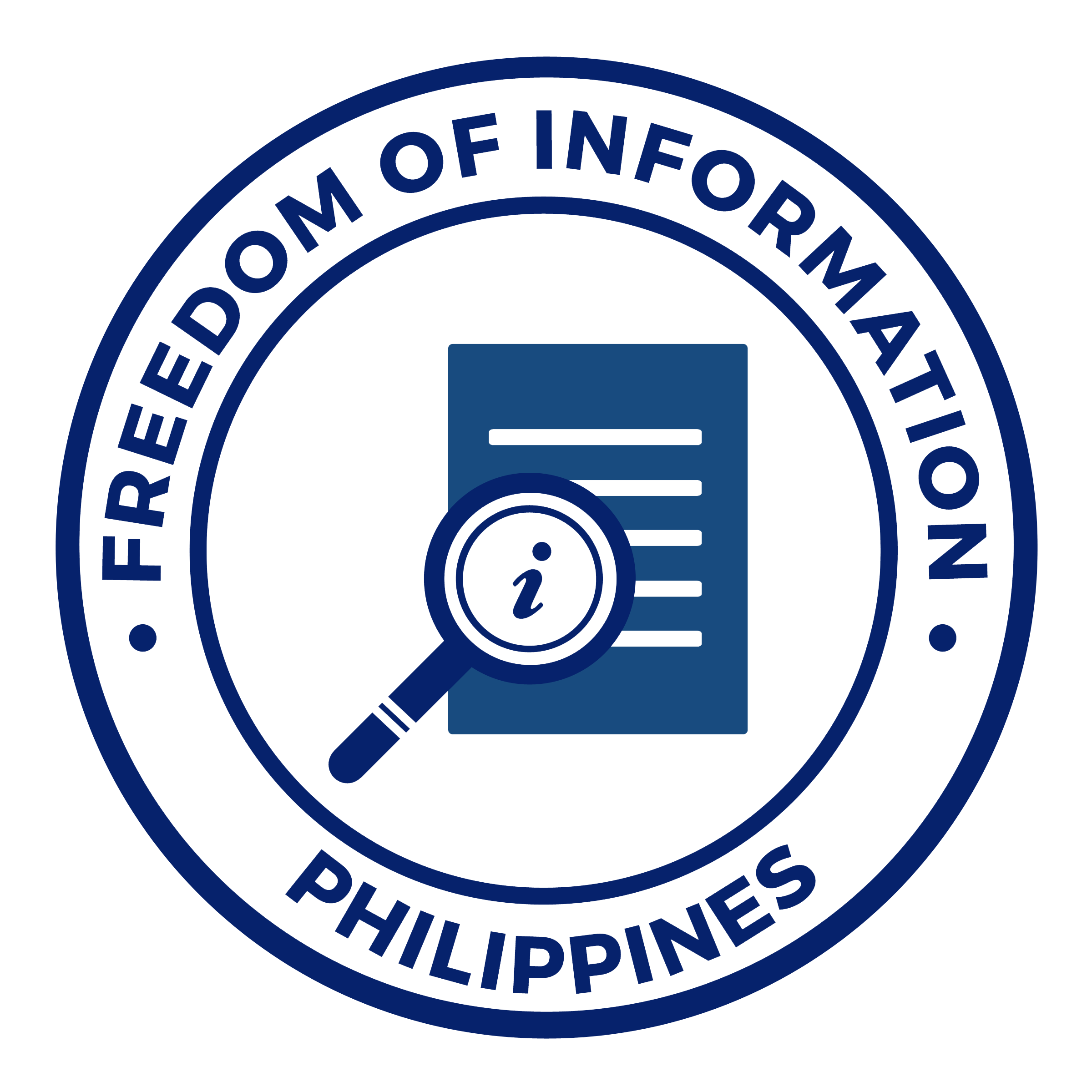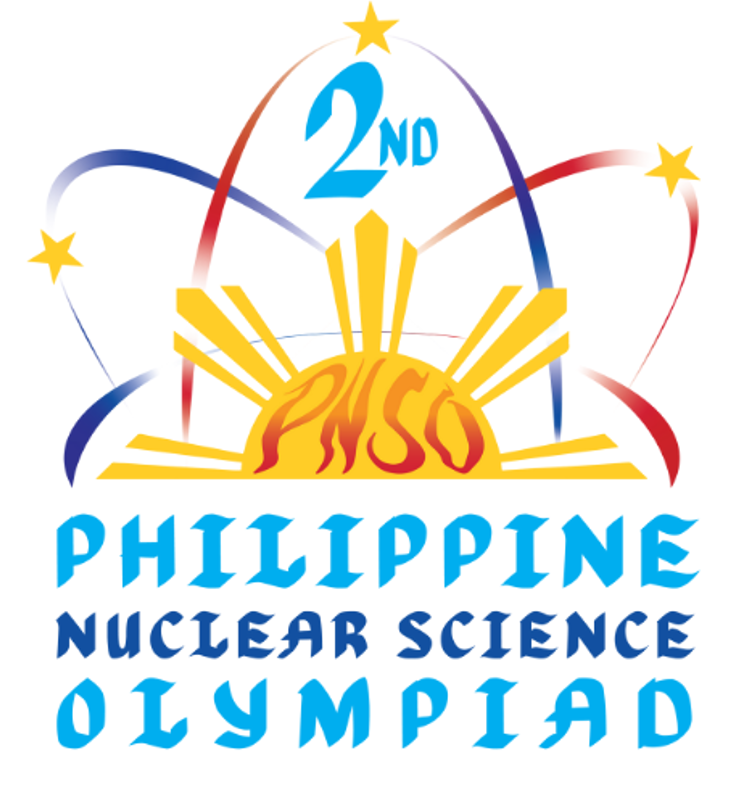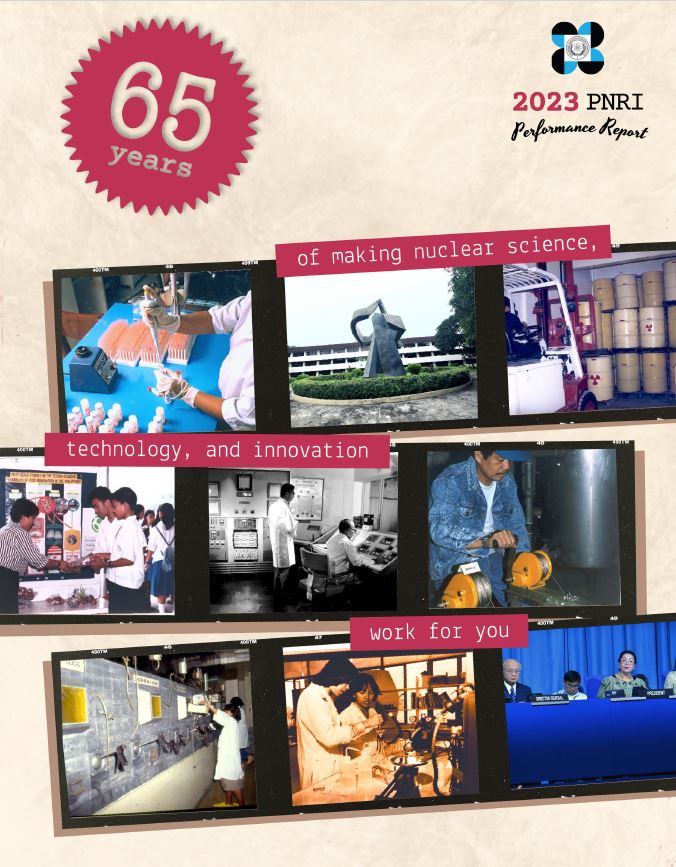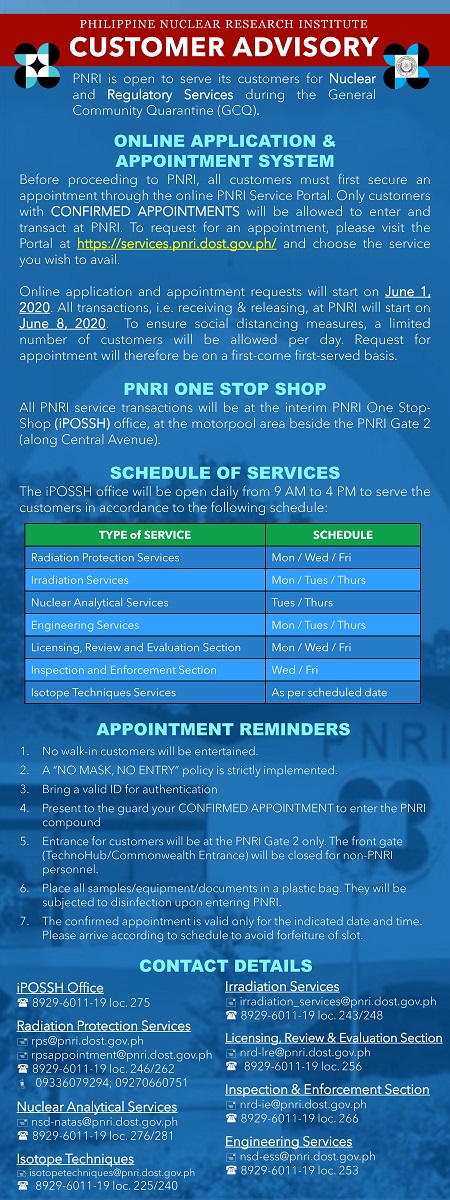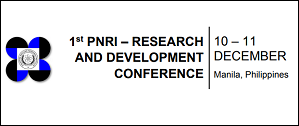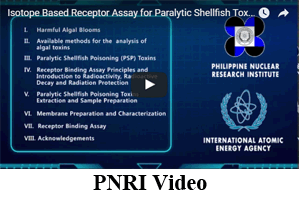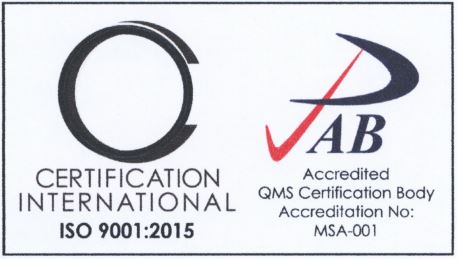Fukushima-Daiichi Nuclear Power Plant Accident in Japan INFORMATION BULLETIN No.22 (11 April 2011 Update as of 11:00 AM)
- Details
- The DOST-PNRI continues to closely monitor the situation at the Fukushima-Daiichi Nuclear Power Plant.
- The condition in the plant remains very serious but not worsening and there are early signs of recovery in some functions such as electrical power and instrumentation.
- The DOST-PNRI does not expect that the Philippine waters will be threatened by the discharge of radiation-contaminated water from the Fukushima plant. Cesium and iodine are soluble in water. The Pacific Ocean is so vast with its sheer volume and depth that the radioactive contaminants will be very much diluted and will not pose harm to the Philippine public and marine organisms.
- To ensure safety of our marine environment and the public, the DOST-PNRI is continuously performing radiological surveillance activities and these include collection, monitoring, and analyses of our marine biota and seawater for radioactivity.
- The Comprehensive Nuclear Test Ban Treaty Organization (CTBTO) air monitoring station in the Philippines being serviced by the DOST-PNRI detected the following radioactivity concentrations:
|
Day |
Iodine-131 |
Cesium-134 |
Cesium-137 |
|
March 23 |
33 |
4.2 |
5.7 |
|
March 24 |
480 |
92 |
120 |
|
March 25 |
54 |
6.3 |
7.7 |
|
March 26 |
20 |
0.7 |
0.7 |
|
March 27 |
47 |
2.6 |
3.1 |
|
March 28 |
93 |
4.4 |
5.3 |
|
March 29 |
130 |
4.6 |
5.3 |
|
March 30 |
210 |
1.7 |
1.6 |
|
March 31 |
31 |
Not detected |
0.7 |
|
April 1 |
57 |
4.3 |
5.7 |
|
April 2 |
61 |
9.9 |
12 |
|
April 3 |
160 |
86 |
100 |
|
April 4 |
79 |
53 |
79 |
|
April 5 |
51 |
18 |
20 |
|
April 6 |
21 |
8.7 |
11 |
*microbecquerels per cubic meter; 1 microbecquerel = 1 x 10-6 becquerel
- The peak values on March 24 correspond to a dose of 131 nanosieverts in a year; sleeping next to someone for 8 hours a day for one year gives a dose of 20,000 nanosieverts because of the natural radioactivity present in the body.
- Activity Concentration of Soil Samples taken from PNRI grounds:
|
Date Collected |
Sample Type |
Activity Concentration, Bq/kg |
||
|
Iodine-131 |
Cesium-134 |
Cesium-137 |
||
|
March 23 |
Topsoil |
Not detected |
Not detected |
**0.064 |
|
March 24 |
Topsoil |
Not detected |
Not detected |
**0.175 |
- Activity Concentration of Water Samples taken from Cagayan and La Mesa Dam:
|
Date Collected |
Sample Type/Site |
Activity Concentration, mBq/L |
||
|
Iodine-131 |
Cesium-134 |
Cesium-137 |
||
|
April 2 |
Seawater/Sta. Ana, Cagayan |
Not detected |
Not detected |
**1.66 |
|
April 5 |
Freshwater/La Mesa Dam |
Not detected |
Not detected |
Not detected |
**The above Cesium-137 levels in the soil and water samples are way below the safe levels.
- Latest DOST-PNRI RADIATION LEVEL CHECK at PNRI grounds as of 9:00 AM, April 11, 2011: 98 to 116 nSv/hr (nanosieverts per hour), STATUS: NORMAL
- For the latest information, please access the following websites:
- International Atomic Energy Agency (IAEA) (http://www.iaea.org/newscenter/news/tsunamiupdate01.html)
- Nuclear and Industrial Safety Administration (NISA) of Japan (www.nisa.meti.go.jp/english/index.html)
- World Health Organization (http://www.who.int/hac/crises/jpn/en/index.html)
- For further advisories, please call the PNRI trunklines with Tel Nos. 929-6010 to 19 or visit the following:
- DOST (www.dost.gov.ph)
- PNRI (www.pnri.dost.gov.ph)
- STII (www.stii.dost.gov.ph)
Fukushima-Daiichi Nuclear Power Plant Accident in Japan INFORMATION BULLETIN No.21 (08 April 2011 Update as of 11:00 AM)
- Details
- The DOST-PNRI continues to closely monitor the situation at the Fukushima-Daiichi Nuclear Power Plant.
- The condition in the plant remains very serious but not worsening and there are early signs of recovery in some functions such as electrical power and instrumentation.
- On 6th April, the IAEA reported that the leakage of water from the sidewall of the pit closest to the sea had stopped after coagulation agents (liquid glass) were injected into the holes drilled around the pits. Work continues to prevent further releases to the sea.
- The DOST-PNRI does not expect that the Philippine waters will be threatened by the discharge of radiation-contaminated water from the Fukushima plant. Cesium and iodine are soluble in water. The Pacific Ocean is so vast with its sheer volume and depth that the radioactive contaminants will be very much diluted and will not pose harm to the Philippine public and marine organisms.
- To ensure safety of our marine environment and the public, the DOST-PNRI is continuously performing radiological surveillance activities and these include collection, monitoring, and analyses of our marine biota and seawater for radioactivity.
- As of 4th April, the Japanese Government imposed food restrictions (distribution and/or consumption) in four prefectures (Fukushima, Ibaraki, Tochigi, and Gunma) and in certain locations in Chiba prefecture (Katori City, Tako Town and Asahi City).
- The IAEA confirms that a 7.1 magnitude earthquake occurred in Japan at 10:32PM (Manila time), 7 April 2011. The epicenter of the earthquake was 20 km from the Onagawa nuclear power plant and approximately 120 km from the Fukushima-Daiichi nuclear power plant. TEPCO reported that the earthquake did not cause further damage to the Fukushima-Daiichi nuclear power plant. Likewise, conditions are reported safe at the Onagawa Nuclear Power Plant which had been on shutdown since March 11, 2011.
- The Comprehensive Nuclear Test Ban Treaty Organization (CTBTO) air monitoring station in the Philippines being serviced by the DOST-PNRI detected the following radioactivity concentrations:
|
Day |
Iodine-131 |
Cesium-134 |
Cesium-137 |
|
March 23 |
33 |
4.2 |
5.7 |
|
March 24 |
480 |
92 |
120 |
|
March 25 |
54 |
6.3 |
7.7 |
|
March 26 |
20 |
0.7 |
0.7 |
|
March 27 |
47 |
2.6 |
3.1 |
|
March 28 |
93 |
4.4 |
5.3 |
|
March 29 |
130 |
4.6 |
5.3 |
|
March 30 |
210 |
1.7 |
1.6 |
|
March 31 |
31 |
Not detected |
0.7 |
|
April 1 |
57 |
4.3 |
5.7 |
|
April 2 |
61 |
9.9 |
12 |
|
April 3 |
160 |
86 |
100 |
|
April 4 |
79 |
53 |
79 |
|
April 5 |
51 |
18 |
20 |
*microbecquerels per cubic meter; 1 microbecquerel = 1 x 10-6 becquerel
- The peak values on March 24 correspond to a dose of 131 nanosieverts in a year; sleeping next to someone for 8 hours a day for one year gives a dose of 20,000 nanosieverts because of the natural radioactivity present in the body.
- Latest DOST-PNRI RADIATION LEVEL CHECK at PNRI grounds as of 9:00 AM, April 8, 2011: 89 to 106 nSv/hr (nanosieverts per hour), STATUS: NORMAL
- For the latest information, please access the following websites:
- International Atomic Energy Agency (IAEA) (http://www.iaea.org/newscenter/news/tsunamiupdate01.html)
- Nuclear and Industrial Safety Administration (NISA) of Japan (www.nisa.meti.go.jp/english/index.html)
- World Health Organization (http://www.who.int/hac/crises/jpn/en/index.html)
- For further advisories, please call the PNRI trunklines with Tel Nos. 929-6010 to 19 or visit the following:
- DOST (www.dost.gov.ph)
- PNRI (www.pnri.dost.gov.ph)
- STII (www.stii.dost.gov.ph)
Fukushima-Daiichi Nuclear Power Plant Accident in Japan INFORMATION BULLETIN No.20 (06 April 2011 Update as of 11:00 AM)
- Details
- The DOST-PNRI continues to closely monitor the situation at the Fukushima-Daiichi Nuclear Power Plant.
- The condition in the plant remains very serious but not worsening.
- TEPCO had been given permission by the Japan Government to discharge 10,000 tons of low level contaminated water into the sea. This is to have sufficient capacity to store highly contaminated water found in the basement of the Unit 2 Turbine building. TEPCO will also discharge 1,500 tons of low level contaminated water in the sub-drain pit for Units 5 and 6. TEPCO has estimated that the potential additional annual dose to a member of the public would be around 0.6 millisievert, if he ate seaweed and seafood caught from near the plant everyday for a year. (The average annual dose from natural background radiation is 2.4 millisieverts.)
- The DOST-PNRI does not expect that the Philippine waters will be threatened by the discharge of radiation contaminated water from the Fukushima plant. Cesium and iodine are soluble in water. The Pacific Ocean is so vast with its sheer volume and depth that the radioactive contaminants will be very much diluted and will not pose harm to the Philippine public and marine organisms.
- Modelling of the dispersion of radioactive isotopes in the ocean has been initiated by the SIROCCO group of the Observatoire Midi-Pyrenees, University of Toulouse, in France. Results showed an initial transport into the northeast direction and fast dispersion along the Kuroshio current. The Philippines is located southwest of Japan. By the time the water current reaches the Philippines, the concentration of radioactive isotopes will be negligible.
- However, to ensure safety of our marine environment and the public, the DOST-PNRI is continuously performing radiological surveillance activities and these include collection, monitoring, and analyses of our marine biota for radioactivity.
- The Comprehensive Nuclear Test Ban Treaty Organization (CTBTO) air monitoring station in the Philippines being serviced by the DOST-PNRI detected the following radioactivity concentrations:
|
Day |
Iodine-131 |
Cesium-134 |
Cesium-137 |
|
March 23 |
33 |
4.2 |
5.7 |
|
March 24 |
480 |
92 |
120 |
|
March 25 |
54 |
6.3 |
7.7 |
|
March 26 |
20 |
0.7 |
0.7 |
|
March 27 |
47 |
2.6 |
3.1 |
|
March 28 |
93 |
4.4 |
5.3 |
|
March 29 |
130 |
4.6 |
5.3 |
|
March 30 |
210 |
1.7 |
1.6 |
|
March 31 to present** |
- |
- |
- |
*microbecquerels per cubic meter; 1 microbecquerel = 1 x 10-6 becquerel
** Data still being processed by CTBTO
- The peak values on March 24 correspond to a dose of 131 nanosieverts in a year; sleeping next to someone for 8 hours a day for one year gives a dose of 20,000 nanosieverts because of the natural radioactivity present in the body.
- Latest DOST-PNRI RADIATION LEVEL CHECK at PNRI grounds as of 9:00 AM, April 6, 2011: 85 to 100 nSv/hr (nanosieverts per hour), STATUS: NORMAL
- For the latest information, please access the following websites:
- International Atomic Energy Agency (IAEA) (http://www.iaea.org/newscenter/news/tsunamiupdate01.html)
- Nuclear and Industrial Safety Administration (NISA) of Japan (www.nisa.meti.go.jp/english/index.html)
- World Health Organization (http://www.who.int/hac/crises/jpn/en/index.html)
- For further advisories, please call the PNRI trunklines with Tel Nos. 929-6010 to 19 or visit the following:
- DOST (www.dost.gov.ph)
- PNRI (www.pnri.dost.gov.ph)
- STII (www.stii.dost.gov.ph)
Fukushima-Daiichi Nuclear Power Plant Accident in Japan INFORMATION BULLETIN No.19 (04 April 2011 Update as of 11:00 AM)
- Details
- The DOST-PNRI continues to closely monitor the situation at the Fukushima-Daiichi Nuclear Power Plant.
- The condition in the plant remains very serious but not worsening.
- The Comprehensive Nuclear Test Ban Treaty Organization (CTBTO) air monitoring station in the Philippines being serviced by the DOST-PNRI detected the following radioactivity concentrations:
|
Day |
Iodine-131 |
Cesium-134 |
Cesium-137 |
|
March 23 |
33 |
4.2 |
5.7 |
|
March 24 |
480 |
92 |
120 |
|
March 25 |
54 |
6.3 |
7.7 |
|
March 26 |
20 |
0.7 |
0.7 |
|
March 27 |
47 |
2.6 |
3.1 |
|
March 28 |
93 |
4.4 |
5.3 |
|
March 29 |
130 |
4.6 |
5.3 |
|
March 30 |
210 |
1.7 |
1.6 |
*microbecquerels per cubic meter; 1 microbecquerel = 1 x 10-6 becquerel
- The peak values on March 24 correspond to a dose of 131 nanosieverts in a year which is approximately 1/4000 of the dose from a single chest X-ray or the dose from 14 kilometers (km) of jet air travel [aerial distance: Manila to Los Angeles, USA is approximately 12,000 km].
- Latest DOST-PNRI RADIATION LEVEL CHECK at PNRI grounds as of 9:00 AM, April 4, 2011: 90 to 110 nSv/hr (nanosieverts per hour), STATUS: NORMAL
- For the latest information, please access the following websites:
- International Atomic Energy Agency (IAEA) (http://www.iaea.org/newscenter/news/tsunamiupdate01.html)
- Nuclear and Industrial Safety Administration (NISA) of Japan (www.nisa.meti.go.jp/english/index.html)
- World Health Organization (http://www.who.int/hac/crises/jpn/en/index.html)
- For further advisories, please call the PNRI trunklines with Tel Nos. 929-6010 to 19 or visit the following:
- DOST (www.dost.gov.ph)
- PNRI (www.pnri.dost.gov.ph)
- STII (www.stii.dost.gov.ph)







